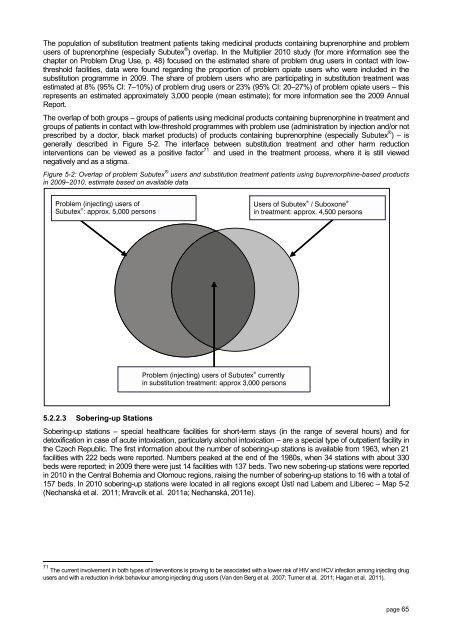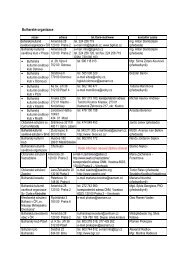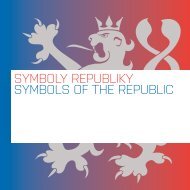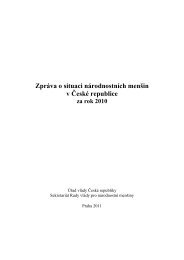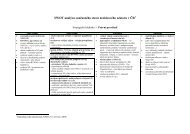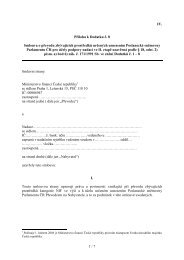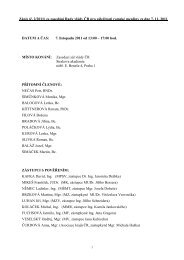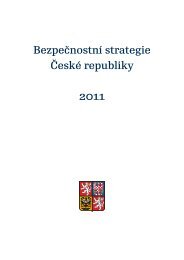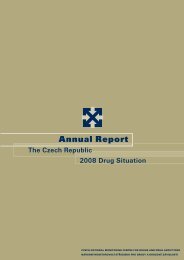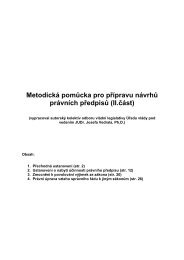The Czech Republic Annual Report 2010 Drug ... - Drogy-info.cz
The Czech Republic Annual Report 2010 Drug ... - Drogy-info.cz
The Czech Republic Annual Report 2010 Drug ... - Drogy-info.cz
Create successful ePaper yourself
Turn your PDF publications into a flip-book with our unique Google optimized e-Paper software.
<strong>The</strong> population of substitution treatment patients taking medicinal products containing buprenorphine and problem<br />
users of buprenorphine (especially Subutex ® ) overlap. In the Multiplier <strong>2010</strong> study (for more <strong>info</strong>rmation see the<br />
chapter on Problem <strong>Drug</strong> Use, p. 48) focused on the estimated share of problem drug users in contact with lowthreshold<br />
facilities, data were found regarding the proportion of problem opiate users who were included in the<br />
substitution programme in 2009. <strong>The</strong> share of problem users who are participating in substitution treatment was<br />
estimated at 8% (95% CI: 7–10%) of problem drug users or 23% (95% CI: 20–27%) of problem opiate users – this<br />
represents an estimated approximately 3,000 people (mean estimate); for more <strong>info</strong>rmation see the 2009 <strong>Annual</strong><br />
<strong>Report</strong>.<br />
<strong>The</strong> overlap of both groups – groups of patients using medicinal products containing buprenorphine in treatment and<br />
groups of patients in contact with low-threshold programmes with problem use (administration by injection and/or not<br />
prescribed by a doctor, black market products) of products containing buprenorphine (especially Subutex ® ) – is<br />
generally described in Figure 5-2. <strong>The</strong> interface between substitution treatment and other harm reduction<br />
interventions can be viewed as a positive factor 71 and used in the treatment process, where it is still viewed<br />
negatively and as a stigma.<br />
Figure 5-2: Overlap of problem Subutex ® users and substitution treatment patients using buprenorphine-based products<br />
in 2009–<strong>2010</strong>, estimate based on available data<br />
5.2.2.3 Sobering-up Stations<br />
Sobering-up stations – special healthcare facilities for short-term stays (in the range of several hours) and for<br />
detoxification in case of acute intoxication, particularly alcohol intoxication – are a special type of outpatient facility in<br />
the <strong>Czech</strong> <strong>Republic</strong>. <strong>The</strong> first <strong>info</strong>rmation about the number of sobering-up stations is available from 1963, when 21<br />
facilities with 222 beds were reported. Numbers peaked at the end of the 1980s, when 34 stations with about 330<br />
beds were reported; in 2009 there were just 14 facilities with 137 beds. Two new sobering-up stations were reported<br />
in <strong>2010</strong> in the Central Bohemia and Olomouc regions, raising the number of sobering-up stations to 16 with a total of<br />
157 beds. In <strong>2010</strong> sobering-up stations were located in all regions except Ústí nad Labem and Liberec – Map 5-2<br />
(Nechanská et al. 2011; Mravcík et al. 2011a; Nechanská, 2011e).<br />
71 <strong>The</strong> current involvement in both types of interventions is proving to be associated with a lower risk of HIV and HCV infection among injecting drug<br />
users and with a reduction in risk behaviour among injecting drug users (Van den Berg et al. 2007; Turner et al. 2011; Hagan et al. 2011).<br />
page 65


